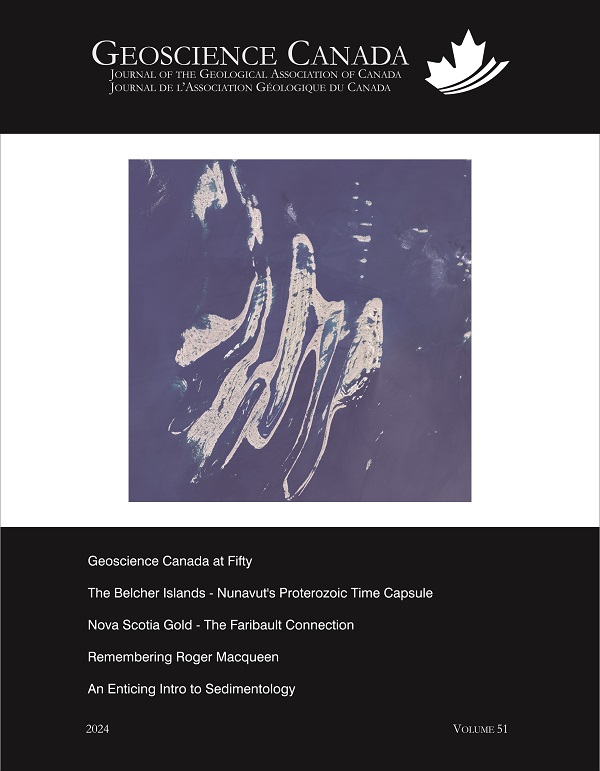Published 2024-04-05
Keywords
- Eugène Faribault,
- Gold,
- Icon,
- Nova Scotia
How to Cite
Abstract
Eugène Rodolphe Faribault proved to be a very good choice as a geologist for the Geological Survey of Canada, after his appointment on July 1, 1883. His career spanned fifty years, time mostly committed to mapping the southwestern half of Nova Scotia, concentrated on the slate and quartzite of the Meguma Supergroup in which gold mining was taking place. In his words, he was, “a specialist on geological maps and structural geology of gold mines in Nova Scotia”. Dozens of his meticulously prepared maps of over sixty gold districts have stood the test of time for accuracy. A popular figure in the field, Faribault made frequent trips to operating mines. He early recognized the existence, in some districts, of extensive bodies of low-grade ore. He emphasized too, the similarities between the ‘saddle reef’ deposits mined in the Bendigo fields of Australia and the auriferous veins of the Meguma formations. His ‘pay-zone’ theory held that near-surface mineable ore in Nova Scotia gold mines should continue at depth, provided the same structural conditions persisted. However, for various reasons his theory received a mixed reception.
Back in Ottawa at the GSC offices, Faribault was a highly respected figure among fellow workers and supervisors alike, and across all departments. His quiet charisma and friendly nature, complemented by professional expertise, won him accolades as an ambassador well beyond the workplace. For his excellence in a young developing science, Faribault thoroughly earned the epithet, “The Grand Old Man of Nova Scotian Geology”.
References
- Barkhouse, Joyce, C., 1974, George Dawson, the little giant: Clark Irwin & Company, Toronto.
- Dawson, J.W., 1878, Acadian geology: the geological structure, organic remains and mineral resources of Nova Scotia, New Brunswick, and Prince Edward Island, third edition: MacMillan and Company, London.
- Doggett, M.D., and Mossman, D.J., 1985, Nova Scotia: examining the possibilities of future gold mining: Canadian Mining Journal, v. 3, p. 36–39.
- Faribault, E.R., 1899, The gold measures of Nova Scotia and deep mining: Journal of the Canadian Mining Institute, v. 2, p. 119–129. [Reprinted in 1903 in The Mining Society of Nova Scotia: Halifax, Kings Printer, p. 5–16].
- Faribault, E.R., 1903, Nova Scotia. Deep gold mining. Report on the best methods of testing the value of the deeper gold deposits of Nova Scotia: Government of Nova Scotia, Report, 16 p.
- Faribault, E.R., 1913, The Gold-bearing series of Nova Scotia: International Geological Congress Guide Book No. 1, p. 158–192.
- Faribault, E.R., 1916, Gold-bearing series in northern portions of Queens and Shelburne counties – infusorial earth deposits at Loon Lake Island, Liverpool River, Queens County, Nova Scotia: Geological Survey of Canada, Summary Report 1915, p. 186–192, https://ostrnrcan-dostrncan.canada.ca/handle/1845/107649.
- Faribault, E.R., 1933, Deep saddle-veins seen as a source of wealth in gold: Port and Province, Halifax, October, p. 8–21.
- Faribault, E.R., 1944, Autobiography and bibliography of Dr. E. Rodolphe Faribault: prepared for the Canadian Institute of Mining and Metallurgy’s “Who’s Who”, Ottawa, Ontario, p.104–108.
- Gregory, D.J., 1975, Bibliography of the geology of Nova Scotia: Nova Scotia Department of Mines, Halifax, Nova Scotia, 237 p.
- Hall, E., 1967, Early Canada: A collection of historical photographs by officers of the Geological Survey of Canada: Geological Survey of Canada, Department of Energy, Mines and Resources, Miscellaneous Report 14, 136 p., https://doi.org/10.4095/119934.
- Libbey, W.L., 1905, Government aid to deep gold mining in Nova Scotia: Journal of the Mining Society of Nova Scotia, v. IX, p. 54–71.
- Malcolm, W., 1929, Gold fields of Nova Scotia: Geological Survey of Canada, Memoir 156, 253 p., https://doi.org/10.4095/119968.
- Mossman, D.J., 1982, Nova Scotian gold: The Mineralogical Record, v. 13, p. 335–344.
- Prest, W.H., 1915, The Gold Fields of Nova Scotia: A prospectors handbook, 1st edition (edited by F.P. Ronnan): The Industrial Publishing Company, Ltd., Halifax, NS, 158 p.
- Raddall, T.H., 1968, Footsteps on old floors. True tales of mystery, Chapter 5, The lost gold of Kejimkujik: Double Day & Company, New York, p. 195–218.
- Rand, S.T, 1875, Micmac grammar: a first reading book in the Micmac language: Nova Scotia Publishing Company, Halifax, NS, 252 p., https://doi.org/10.5479/sil.266719.39088005794854.
- Rickard, T.A., 1927, Gold mining in Nova Scotia: Nova Scotia Annual Report on Mines, p.163–177.
- Roy, P.-G., 1913, La famille Faribault: published in Lévis, Québec [publisher not identified], 47 p., https://www.canadiana.ca/view/oocihm.66920.
- Weeks, L.J., 1954, Eugène Rodolphe Faribault: Transactions of the Royal Society of Canada, Section IV, p. 69–73.
- White, C.E., 2010, Stratigraphy of the Lower Paleozoic Goldenville and Halifax groups in southwestern Nova Scotia: Atlantic Geology, v. 46, p. 136–154, https://doi.org/10.4138/atlgeol.2010.008.
- Woodman, J.E., 1902, Geology of the Moose River district, Halifax County, Nova Scotia; together with the pre-Carboniferous history of the Meguma Series: Unpublished PhD thesis, Harvard University, Cambridge, MA, 353 p.
- Zaslow, M., 1975, Reading the rocks: the story of the Geological Survey of Canada 1842–1972: The Macmillan Company of Canada Ltd., Toronto, ON, 599 p., https://doi.org/10.4095/308420.
